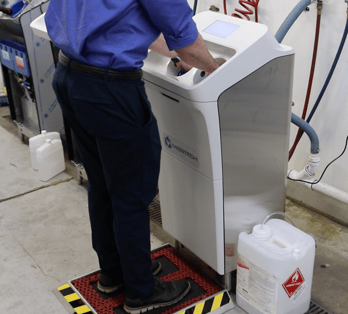Implementing Internal Food Safety Audit Procedures
In today's fast-paced and interconnected world, where consumers are obsessed with the latest food and health trends, it's more important than ever to make sure that the food we consume is safe. Food safety isn't just a legal requirement, it's a crucial part of keeping ourselves and customers healthy. One of the best ways to ensure food safety is through regular and comprehensive food safety audits. In this blog post, we're going to dig into the details of implementing effective food safety audit procedures for your business.
The Significance of Food Safety Audits
 Food safety audits play a vital role in ensuring the safety of the food we consume. These audits protect us from potential dangers and guarantee the safety of our meals. In a world where foodborne illnesses and allergens are becoming more and more worrisome, it's absolutely crucial for food-related businesses to have effective food safety audit procedures in place. These audits not only protect consumers from potential dangers but also boost the reputation of the company and bring transparency to the industry.
Food safety audits play a vital role in ensuring the safety of the food we consume. These audits protect us from potential dangers and guarantee the safety of our meals. In a world where foodborne illnesses and allergens are becoming more and more worrisome, it's absolutely crucial for food-related businesses to have effective food safety audit procedures in place. These audits not only protect consumers from potential dangers but also boost the reputation of the company and bring transparency to the industry.
Key Steps to Implement Effective Food Safety Audit Procedures
1. Establish Clear Objectives
To get those food safety audit procedures up and running smoothly, businesses need to consider a few key steps. First things first, establish some clear objectives for the audit. Figure out what you want to achieve, whether it's making sure you're following all the regulations, identifying risks, or just improving the overall quality of your operation. Having these objectives in place will keep your audit focused and on track.
2. Select the Right Audit Team
Now comes the exciting part – selecting the ultimate audit team. You need auditors who are highly skilled in their field, with a wealth of expertise and experience in food safety. These individuals should have extensive knowledge of industry regulations, standards, and best practices, making them the perfect fit for your team. Their ability to remain neutral and pay attention to every detail is absolutely crucial for a successful audit.
3. Develop a Comprehensive Audit Plan
Now that you've assembled your team of auditors, it's time to create a rock-solid audit plan. This will lay out the scope, schedule, methodologies, and resources needed to tackle the audit. It's like a road map for the audit process, ensuring that no stone is left unturned.
4. Conduct a Pre-Audit Assessment
 Before the official audit gets underway, it's a smart move to do a pre-audit assessment of your organization's operations. This preliminary check helps you uncover any potential gaps or concerns that should be dealt with before the big audit. It's a proactive way to tackle any issues head-on and ensure a smoother audit process.
Before the official audit gets underway, it's a smart move to do a pre-audit assessment of your organization's operations. This preliminary check helps you uncover any potential gaps or concerns that should be dealt with before the big audit. It's a proactive way to tackle any issues head-on and ensure a smoother audit process.
Download our Hand Hygiene Audit Tool
5. Gather Necessary Documentation
To get ready for the audit, round up all the necessary paperwork, like food safety policies, procedures, training records, and regulatory compliance reports. These documents give a peek into how well the organization follows food safety protocols and act as evidence during the audit.

CleanTech® Automated Handwashing Stations revolutionize hand hygiene compliance in the food industry by tracking handwashing compliance and collecting data during every hand wash. This real-time tracking can lead to actionable insights to improve practices and maintain high food safety standards, ensuring a reliable system to monitor and improve hand hygiene compliance.
Learn more about how CleanTech® monitors compliance
6. On-site Audit
When it's time for the on-site audit, auditors will be like food safety detectives, conducting interviews, observations, and inspections to find out the truth about food handling practices, cleanliness, sanitation, and employee knowledge.This step functions as an investigative mission to assess the actual implementation of documented procedures, while also uncovering any hidden non-conformities that may be present.
7. Identify Non-Conformities
Identifying the discrepancies between what is observed and what the standards dictate can be quite the challenge. Adopt a vigilant approach and thoroughly evaluate any non-conformities, considering their seriousness and potential effects on food safety. This essential step will assist us in determining the priority of issues to address first and maintaining a proactive stance towards upholding food safety standards.
Download our Food Safety Sanitation Maintenance Guide
8. Develop Corrective Action Plans
Once you've identified those non-conformities, it's time to rally the troops and develop some corrective action plans. These plans should lay out the specific steps, responsible individuals, timelines, and measurable outcomes needed to tackle those non-conformities and up your food safety game. Implementing these action plans is absolutely crucial to ensure that your business is on the right track and providing safe and healthy products.
9. Implement Continuous Improvement
 Consider food safety audits as an opportunity to enhance your practices and excel in your industry. By consistently reviewing and fine-tuning your food safety procedures based on audit findings, new regulations, and the latest and greatest practices, you'll stay on top of your compliance game and keep those risks at bay.
Consider food safety audits as an opportunity to enhance your practices and excel in your industry. By consistently reviewing and fine-tuning your food safety procedures based on audit findings, new regulations, and the latest and greatest practices, you'll stay on top of your compliance game and keep those risks at bay.
Watch our Webinar on standardizing hygiene SOPs
10. Document and Review
Keeping meticulous records of the audit process, findings, corrective actions, and outcomes is absolutely crucial. This paperwork serves as a historical account and adds a touch of transparency in case there are any regulatory or customer inquiries. It shows that you're serious about food safety and helps you maintain the trust of your consumers.
To wrap things up, implementing effective food safety audit procedures is an absolute must for any food-related business. By setting clear objectives, assembling the ultimate audit team, crafting a rock-solid plan, and constantly improving food safety practices, businesses can kick risks to the curb, meet all the rules and regulations, and maintain the trust of their customers. Remember, food safety is a team effort, and it takes unwavering dedication and watchfulness to uphold the highest standards of quality and safety.






